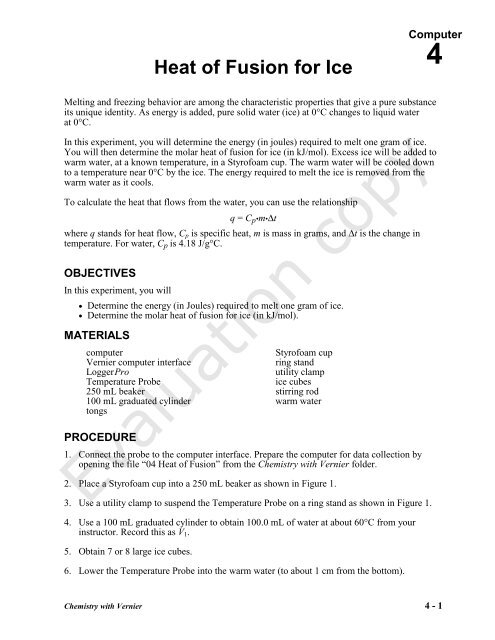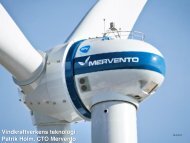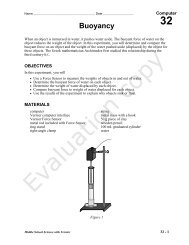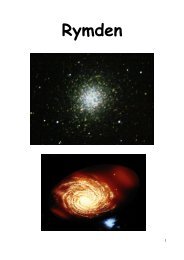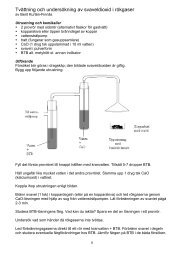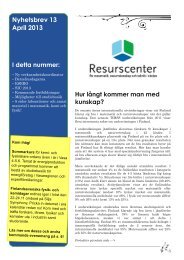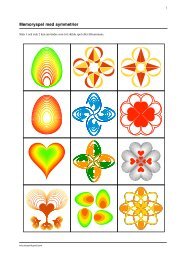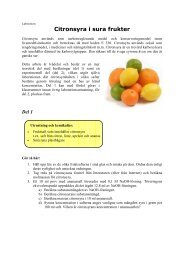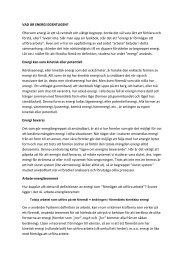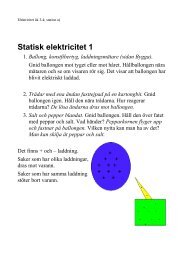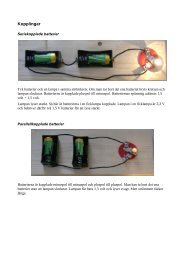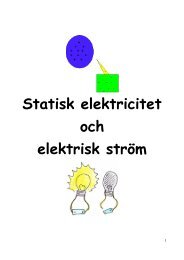Heat of Fusion for Ice - Vernier Software & Technology
Heat of Fusion for Ice - Vernier Software & Technology
Heat of Fusion for Ice - Vernier Software & Technology
- No tags were found...
You also want an ePaper? Increase the reach of your titles
YUMPU automatically turns print PDFs into web optimized ePapers that Google loves.
<strong>Heat</strong> <strong>of</strong> <strong>Fusion</strong> <strong>for</strong> <strong>Ice</strong>Computer4Melting and freezing behavior are among the characteristic properties that give a pure substanceits unique identity. As energy is added, pure solid water (ice) at 0°C changes to liquid waterat 0°C.In this experiment, you will determine the energy (in joules) required to melt one gram <strong>of</strong> ice.You will then determine the molar heat <strong>of</strong> fusion <strong>for</strong> ice (in kJ/mol). Excess ice will be added towarm water, at a known temperature, in a Styr<strong>of</strong>oam cup. The warm water will be cooled downto a temperature near 0°C by the ice. The energy required to melt the ice is removed from thewarm water as it cools.To calculate the heat that flows from the water, you can use the relationshipq = C p •m•∆twhere q stands <strong>for</strong> heat flow, C p is specific heat, m is mass in grams, and ∆t is the change intemperature. For water, C p is 4.18 J/g°C.OBJECTIVESIn this experiment, you will• Determine the energy (in Joules) required to melt one gram <strong>of</strong> ice.• Determine the molar heat <strong>of</strong> fusion <strong>for</strong> ice (in kJ/mol).MATERIALScomputerStyr<strong>of</strong>oam cup<strong>Vernier</strong> computer interfacering standLogger Proutility clampTemperature Probeice cubes250 mL beaker stirring rod100 mL graduated cylinder warm watertongsPROCEDURE1. Connect the probe to the computer interface. Prepare the computer <strong>for</strong> data collection byopening the file “04 <strong>Heat</strong> <strong>of</strong> <strong>Fusion</strong>” from the Chemistry with <strong>Vernier</strong> folder.Evaluation copy2. Place a Styr<strong>of</strong>oam cup into a 250 mL beaker as shown in Figure 1.3. Use a utility clamp to suspend the Temperature Probe on a ring stand as shown in Figure 1.4. Use a 100 mL graduated cylinder to obtain 100.0 mL <strong>of</strong> water at about 60°C from yourinstructor. Record this as V 1 .5. Obtain 7 or 8 large ice cubes.6. Lower the Temperature Probe into the warm water (to about 1 cm from the bottom).Chemistry with <strong>Vernier</strong> 4 - 1
Computer 47. Click to begin data collection. Wait until the temperature reaches a maximum (it willtake a few seconds <strong>for</strong> the cold probe to reach the temperature <strong>of</strong> the warm water). Thismaximum will determine the initial temperature, t 1 , <strong>of</strong> the water. As soon as this maximumtemperature is reached, fill the Styr<strong>of</strong>oam cup with ice cubes. Shake excess water from theice cubes be<strong>for</strong>e adding them (or dry with a paper towel). Record the maximum temperature,t 1 , in your data table.Figure 18. Use a stirring rod to stir the mixture as the temperature approaches 0°C. Important: As theice melts, add more large ice cubes to keep the mixture full <strong>of</strong> ice!9. When the temperature reaches about 4°C, quickly remove the unmelted ice (using tongs).Continue stirring until the temperature reaches a minimum (and begins to rise). Thisminimum temperature is the final temperature, t 2 , <strong>of</strong> the water. Record t 2 in your data table.Click when you have finished collecting data.10. Use the 100 mL graduated cylinder to measure the volume <strong>of</strong> water remaining in theStyr<strong>of</strong>oam cup to the nearest 0.1 mL. Record this as V 2 .11. You can confirm your data by clicking the Statistics button, . The minimum temperature(t 2 ) and maximum temperature (t 1 ) are listed in the floating box on the graph.PROCESSING THE DATA1. Use the equation ∆t = t 2 – t 1 to determine ∆t, the change in water temperature.2. Subtract to determine the volume <strong>of</strong> ice that was melted (V 2 –V 1 ).3. Find the mass <strong>of</strong> ice melted using the volume <strong>of</strong> melt (use 1.00 g/mL as the density <strong>of</strong> water).4. Use the equation given in the introduction <strong>of</strong> this experiment to calculate the energy (injoules) released by the 100 g <strong>of</strong> liquid water as it cooled through ∆t.5. Now use the results obtained above to determine the heat <strong>of</strong> fusion—the energy required tomelt one gram <strong>of</strong> ice (in J/g H 2 O).4 - 2 Chemistry with <strong>Vernier</strong>
<strong>Heat</strong> <strong>of</strong> <strong>Fusion</strong> <strong>for</strong> <strong>Ice</strong>6. Use your answer to Step 5 and the molar mass <strong>of</strong> water to calculate the molar heat <strong>of</strong> fusion<strong>for</strong> ice (in kJ/mol H 2 O).7. Find the percent error <strong>for</strong> the molar heat <strong>of</strong> fusion value in Step 6. The accepted value <strong>for</strong>molar heat <strong>of</strong> fusion is 6.01 kJ/mol.DATA AND CALCULATIONSInitial water temperature, t 1 °CFinal water temperature, t 2 °CChange in water temperature, ∆t °CFinal water volume, V 2Initial water volume, V 1Volume <strong>of</strong> meltmLmLmLMass <strong>of</strong> ice melted<strong>Heat</strong> released by cooling water (q = C p •m•∆t)gJ/g ice melted (heat <strong>of</strong> fusion)JkJ/mol ice melted (molar heat <strong>of</strong> fusion)J/gPercent errorkJ/mol%Chemistry with <strong>Vernier</strong> 4 - 3
<strong>Vernier</strong> Lab Safety Instructions DisclaimerTHIS IS AN EVALUATION COPY OF THE VERNIER STUDENT LAB.This copy does not include:• Safety in<strong>for</strong>mation• Essential instructor background in<strong>for</strong>mation• Directions <strong>for</strong> preparing solutions• Important tips <strong>for</strong> successfully doing these labsThe complete Chemistry with <strong>Vernier</strong> lab manual includes 36 labs and essential teacherin<strong>for</strong>mation. The full lab book is available <strong>for</strong> purchase at:http://www.vernier.com/cmat/cwv.html<strong>Vernier</strong> S<strong>of</strong>tware & <strong>Technology</strong>13979 S.W. Millikan Way • Beaverton, OR 97005-2886Toll Free (888) 837-6437 • (503) 277-2299 • FAX (503) 277-2440info@vernier.com • www.vernier.com


